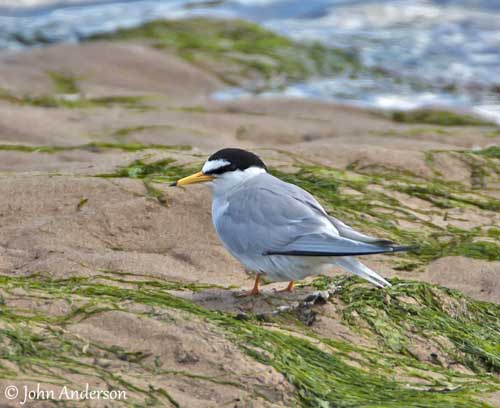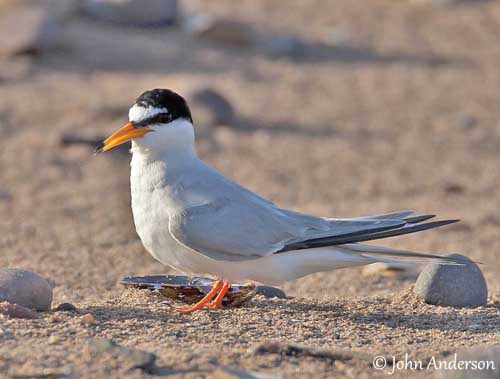
Fr: Sterne naine
All : Zwergseeschwalbe
Esp : Charrancito Común
Ital : Fraticello
Nd : Dwergstern
Sd : Småtärna
Photographers :
John Anderson
John Anderson Photo Galleries
Didier Buysse
Vision d’Oiseaux
Ingo Waschkies
Bird Photography
Text by Nicole Bouglouan
Sources :
HANDBOOK OF THE BIRDS OF THE WORLD Vol 3 by Josep del Hoyo-Andrew Elliott-Jordi Sargatal - Lynx Edicions - ISBN : 8487334202
A Field Guide to the Birds of South-East Asia by Craig Robson. New Holland Publishers. ISBN: 9781780090498
BIRDS OF THE GAMBIA AND SENEGAL by Clive Barlow and Tim Wacher – Helm Field guides – ISBN: 0713675497
THE COMPLETE BOOK OF BRITISH BIRDS – Written by “Royal Society for the Protection of Birds” experts - Préface de Magnus Magnusson - Michael Cady- Rob Hume Editors - ISBN: 0749509112
THE HANDBOOK OF BIRD IDENTIFICATION FOR EUROPE AND THE WESTERN PALEARCTIC by Mark Beaman, Steve Madge - C.Helm - ISBN: 0713639601
BirdLife International (BirdLife International)
What Bird-The ultimate Bird Guide (Mitchell Waite)
Wikipedia, the free encyclopaedia
Little Tern
Sternula albifrons
Charadriiforme Order – Laridae Family
INTRODUCTION:
The Little Tern is the smallest European tern. This species is migratory and winters southwards. It is mainly found in coastal areas and feeds by hovering before diving, sometimes in small, synchronized groups. They feed usually about 3-4 kilometres from their breeding colonies.
DESCRIPTION OF THE BIRD:
Biometrics:
Length: 22-28 cm
Wingspan: 47-55 cm
Weight: 47-63 g
The adult has grey back and upperwing, and white rump, forked tail and underparts. The outermost primaries are blackish.
On the head, crown and lores are black, whereas the forehead is white.
The long, thin bill is bright yellow with reduced black tip. The eyes are dark brown. Legs and feet are yellow to orange-yellow.
Both sexes are similar.

The non-breeding adults have pale-streaked forecrown, white lores and black spot before the eye. The lesser coverts are dark. Legs, feet and bill are blackish.
The juvenile has black-edged mantle feathers. Its plumage is white except dark wing-coverts and outer primaries. Secondaries and inner primaries are paler. It acquires the 1st winter plumage in October, and resembles non-breeding adults.
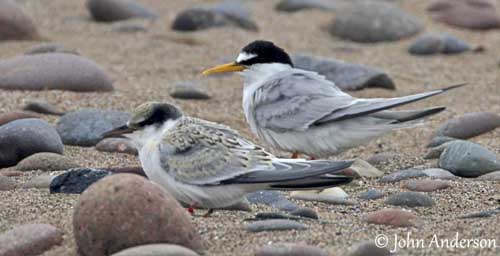
SUBSPECIES AND RANGE:
The Little Tern has six subspecies which differ little.
S.a. albifrons (here described) is found in Europe, through W Asia, E to Nepal and probably in Kenya and in W Indian Ocean. It winters on coasts from Africa E to W India.
S.a. guineae occurs in Ghana to Gabon, with some populations in Mauritania and Senegal.
S.a. innominata is found on Persian Gulf islands.
S.a. pusilla occurs in NE India and Myanmar, Sumatra and Java islands, and probably Sri Lanka.
S.a. sinensis is found in SE Russia, China, Japan, SE Asia, Philippines and New Guinea. There are probably other populations in Australia, New Britain and nearby waters. This race winters in Malaysia.
S.a. placens occurs in E Australia and E Tasmania.
HABITAT:
The Little Tern frequents subtropical and temperate regions, and can be seen up to 2000 metres of elevation in Armenia. Populations living in continents are mainly found in coastal areas, but also inland along rivers. They occur on oceanic islands too.
This species breeds on barren ground or sparsely vegetated sites such as sandy, shell, rocky islands, beaches, estuaries, lakes, salt-marshes, rivers and reefs. But it may occur on bare mud or in grassy areas too.
Outside the breeding season, this species is mainly found in tidal creeks and coastal lagoons, but it may feed at sea.
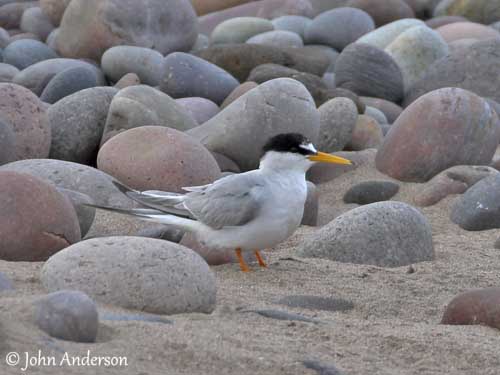
CALLS AND SONGS: SOUNDS BY XENO-CANTO
The Little Tern’s typical call is a sharp “kik-kik” often given in flight, and we can also hear a harsh “kyik” as alarm call, and a rapidly repeated “kirrikikki, kirrikikki”. The juvenile utters a piping “piepp”.
The breeding colonies are very noisy.
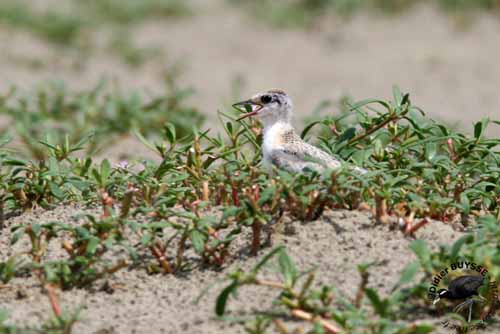
BEHAVIOUR IN THE WILD:
The Little Tern feeds primarily on small fish (3-6 cm) and crustaceans, but also insects, annelids and molluscs.
This species forages by quartering over water, flying back and forth over the water surface. It often hovers and performs plunge-diving into shallow water, in order to catch preys. They may hunt in groups and the birds dive synchronously head down before plunging.
Insects are caught inland from the vegetation. But the bird performs aerial-dipping on water surface, or hawks flying insects over water. It usually feeds close to the beach.
They gather to roost with other species, often larger terns.
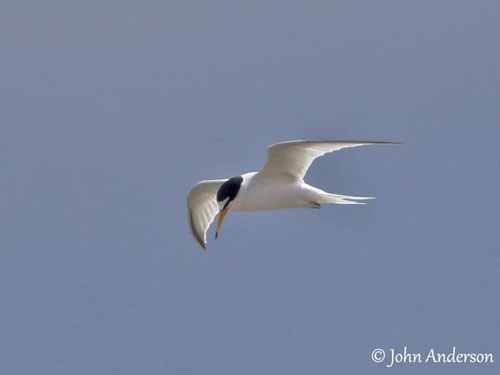
During the breeding season, the male performs aerial displays during which it calls while bringing a fish to attract a female. Both birds fly together high in the air and alternating glides on stiff wings. The female swallows the fish brought by the male, or keeps it in her bill during displays.
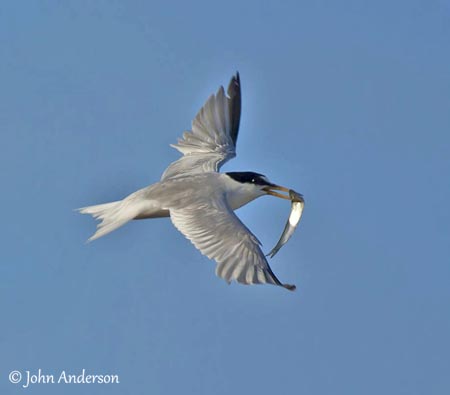
Courtship displays become more frequent once the pair is formed, and courtship feeding is common. Usually, the female remains on the territory and defends it, while the male feeds her regularly. Copulation may follow fish-transfer without prolonged displays.
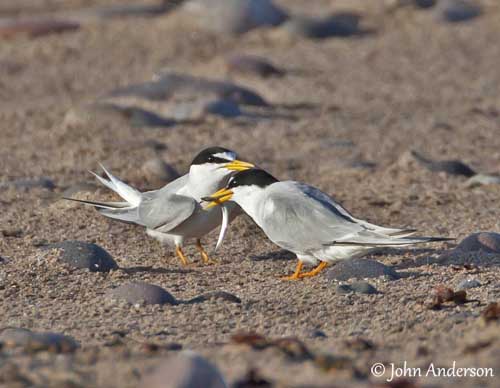
Other nuptial behaviour takes place on the ground. Both mates circle around each other with slightly drooped wings and lowered bill. Then, the male points its bill upright while calling softly with drooped wings. Copulation follows this display.
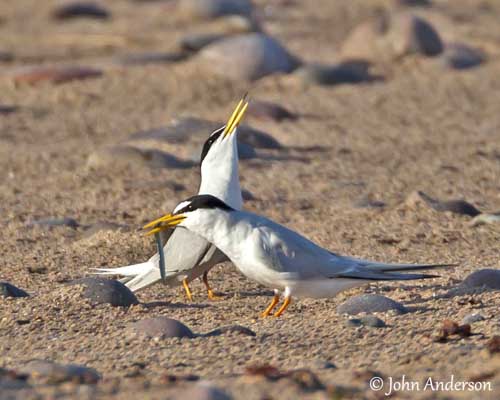
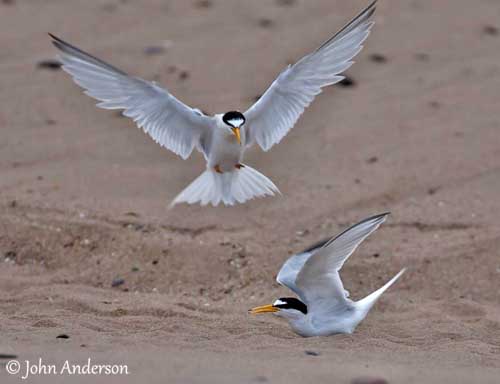
In territorial defence, the tern walks or flies towards opponents. They may perform aerial chases and aerial fights, and several displays involving exaggerated movements.
The Little Tern populations from the northernmost parts of the range migrate south after the nesting period. They may congregate in large numbers at abundant food sources.
This tern is very agile in flight. It can hover when looking for fish before to dive down. The direct flight is performed on rapid wingbeats, much quicker than other terns except during displays.
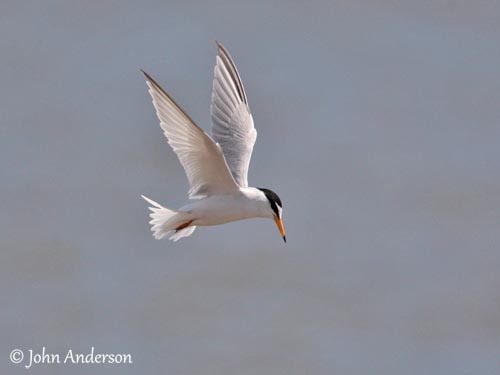
REPRODUCTION OF THIS SPECIES:
The breeding season varies according to the range, but usually takes place when the food resources are abundant.
The Little Tern breeds in small to medium monospecific colonies, rarely more than 100 pairs with nest placed at least 2 metres apart.
The nest is a scrape on the ground, on beaches of sand, pebbles, shell pieces, coral or rock, usually placed above the high tide-line, a few metres away from water. However, in marshy areas, the Little Tern may build a platform of vegetation or shells.
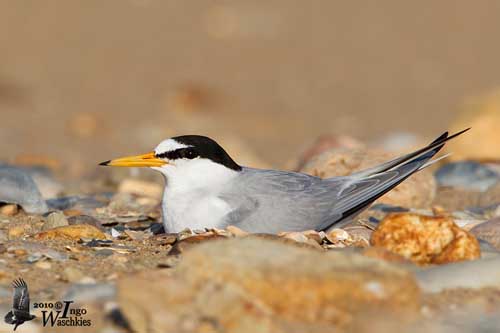
The female lays 2-3 creamy-white eggs with dark markings, and the downy chicks show similar plumage colour at hatching. Incubation by both parents lasts 21-24 days. The chicks are fed during about two months. They fledge 20-24 days after hatching, and can breed at 2-3 years old.
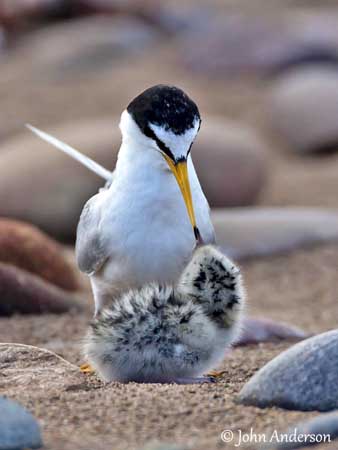
PROTECTION / THREATS / STATUS:
The Little Tern is not currently threatened in spite of several local declines. This species is vulnerable to human disturbances on beaches, and to predation by gulls and Corvids at colonies.
This species has usually low breeding success rate due to loss of eggs and chicks by predation, flooding of nest-site and bad weather involving nest failure.
